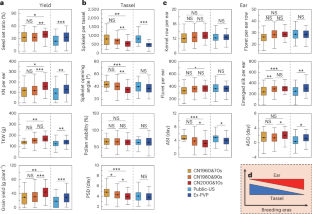在气候变暖的情况下,培育小穗玉米会威胁产量
IF 29.6
1区 地球科学
Q1 ENVIRONMENTAL SCIENCES
引用次数: 0
摘要
育种计划提高了包括玉米(Zea mays L.)在内的主要农作物的产量,但优化后的性状是否适合未来气候仍不清楚。在此,我们通过比较不同育种时代的 323 个玉米近交系新品种在自然田间条件下的反应,发现在标准生长条件下,新品系的谷物产量高于早期发布的品系,但育成的减小穗尺寸的性状增加了新发布品系在开花期对高温的敏感性。我们确定了每穗小穗的潜在阈值(约 700 个),超过这个阈值,玉米就能在温暖条件下产生稳定的高结实率,结果表明,小穗(每穗 700 个小穗)基因型目前在全球 23.7% 的玉米种植区不适用。我们的研究突出表明,有必要考虑育种计划可能导致的气候变化适应不良。本文章由计算机程序翻译,如有差异,请以英文原文为准。


Maize breeding for smaller tassels threatens yield under a warming climate
Breeding programmes have increased the yields of major crops, including maize (Zea mays L.), but the suitability of optimized traits to future climates remains unclear. Here, by comparing the responses of 323 elite maize inbred lines from different breeding eras under natural field conditions, we show that while newer lines exhibit higher grain yield than the early released lines under standard growth, the bred trait of reduced tassel size increases the susceptibility of newly released lines to high temperature during flowering. We identified a potential threshold for spikelets per tassel (~700), over which maize can produce a stably high seed set ratio under warm conditions, and show that small-tassel (<700 spikelets per tassel) genotypes are now unsuitable in 23.7% of global maize-growing regions. Our work highlights the need to consider possible climate change maladaptation resulting from breeding programmes. By comparing the responses of 323 elite maize lines from different breeding eras, the authors demonstrate that reduced tassel size in newer lines can lead to increased susceptibility to high temperature. This highlights the potential for traits optimized by breeding to lead to climate maladaptation.
求助全文
通过发布文献求助,成功后即可免费获取论文全文。
去求助
来源期刊

Nature Climate Change
ENVIRONMENTAL SCIENCES-METEOROLOGY & ATMOSPHERIC SCIENCES
CiteScore
40.30
自引率
1.60%
发文量
267
审稿时长
4-8 weeks
期刊介绍:
Nature Climate Change is dedicated to addressing the scientific challenge of understanding Earth's changing climate and its societal implications. As a monthly journal, it publishes significant and cutting-edge research on the nature, causes, and impacts of global climate change, as well as its implications for the economy, policy, and the world at large.
The journal publishes original research spanning the natural and social sciences, synthesizing interdisciplinary research to provide a comprehensive understanding of climate change. It upholds the high standards set by all Nature-branded journals, ensuring top-tier original research through a fair and rigorous review process, broad readership access, high standards of copy editing and production, rapid publication, and independence from academic societies and other vested interests.
Nature Climate Change serves as a platform for discussion among experts, publishing opinion, analysis, and review articles. It also features Research Highlights to highlight important developments in the field and original reporting from renowned science journalists in the form of feature articles.
Topics covered in the journal include adaptation, atmospheric science, ecology, economics, energy, impacts and vulnerability, mitigation, oceanography, policy, sociology, and sustainability, among others.
 求助内容:
求助内容: 应助结果提醒方式:
应助结果提醒方式:


